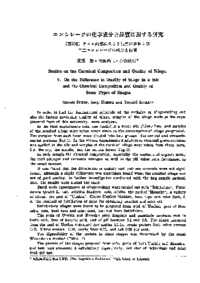エンシレージの化学成分と品質に関する研究 (第5報) サイロ内部位による品質の差および二三エンシレージの成分と品質
Permalink : https://ousar.lib.okayama-u.ac.jp/127
| Eprint ID | 127
|
| FullText URL | |
| Title Alternative | Studies on the Chemical Composition and Quality of Silage. : V. On the Difference in Quality of Silage in a Silo and the Chemical Composition and Quality of Some Types of Silages.
|
| Author |
Sutoh, Hiroshi
Uchida, Senji
Komaki, Toshiro
|
| Abstract | In order to find the fundamental principle of the technics of silage-making and also the factors governing quality of silage, samples of the silage made at the experimental farm of this university, were analyzed. In the first experiments corn was ensiled in a tower silo (2.5m×7m), and samples of the resulted silage were taken seven times as the consumption of silage progressed. The samples from each layer were divided into two groups, the central and circumferential portions (Fig. 1). In the second experiments a mixture of corn and green soybeans was ensiled in the silo and samples of the resulted silage were taken from three parts, i. e. the top, the middle, and the bottom layers (Fig. 2). In each sample the chemical composition, especialiy the contents of organic acids, the total nitrogen and ammonia nitrogen as well as the pH value were determined in the usual manner. It was found that the differences in quality and nutrient contents were not significant, although a slight difference was sometimes found when the resulted silage was not of good quality. In further investigation conducted with the bag sample method, also, the results were almost the same. Small scale experiments of silage-making were carried out with "Sekishomo", Vallisneria spralis L. var. asiatica MAKINO, cale, alfalfa, the peel of "Hassaku", a variety of citrus, the peel of "Unshiu", Citrus Unshiu MAKINO, beet tops and mint feed, i. e. the residual of distillation of mint for obtaining menthol and mint oil. Satisfactory silages were found to be prepared from peel of Unshiu, peel of Hassaku, cale, beet tops and mint feed, but not from Sekishomo. The peels of Unshiu and Hassaku gave fragrant and paratable products rich lactic acid, free of butyric acid, and of pH between 3.1 and 3.8. The silage prepared from the peel of Unshiu contained dry matter 23.35, crude protein 2.03, ether extract 0.45, N-free extract 10.08, crude fiber 0.35, and ash 0.89 per cent. The digestibility of the protein in these silages was determined by the usual WEDEMEYER method (Table 14). The protein of the silages Prepared from cale, peels of both Unshiu and Hassaku, and beet tops possessed a satisfactory digestibility, but that of Sekishomo and mint feed did not. The results of the calculation of the digestibility of silage protein by three different methods, WATSON'S, DIJKSTRA'S, and BARNETT'S, may be considered almost to agree.
|
| Published Date | 1960
|
| Publication Title |
岡山大学農学部学術報告
|
| Publication Title Alternative | Scientific Reports of the Faculty of Agriculture Okayama University
|
| Volume | volume16
|
| Issue | issue1
|
| Publisher | 岡山大学農学部
|
| Publisher Alternative | Faculty of Agriculture, Okayama University
|
| Start Page | 53
|
| End Page | 64
|
| ISSN | 0474-0254
|
| NCID | AN00033029
|
| Content Type |
Departmental Bulletin Paper
|
| language |
Japanese
|
| File Version | publisher
|
| Refereed |
False
|
| Eprints Journal Name | srfa
|
